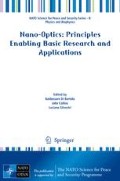Abstract
Standard gold in the field of plasmonics is obtained by evaporation or sputtering and therefore is polycrystalline. Yet, this gold presents numbers of drawbacks such as roughness, grains and ill-defined electronic band diagrams in addition to the lack of reproducibility from one instrument to another. It is, thus, beneficial to turn to a metal production that can enable well-defined and controlled gold parameters. To that end, we have explored the wet synthesis of gold nanoplates which represents a simple and robust means of obtaining single-crystal gold (Guo Z, Zhang Y, DuanMu Y, Xu L, Xie S, Gu N, Colloids Surf A 278:33–38, 2006). The synthesized nanoplates are from 50 to less than 100 nm in thickness and can span over micrometers in lateral dimensions corresponding to areas of several hundreds of μm2. They can thus be considered as thin film material perfectly suitable for plasmonic applications.
We have carried out non-linear, confocal, hyperspectral, optical measurements of such synthesized nanoplates and compared them to those of gold-evaporated nanoplates of similar dimensions. The single-crystal gold nanoplates are brighter at the second harmonic generation (SHG) wavelength than at multi-photon absorption luminescence (MPL) wavelengths whereas the opposite is observed for the polycrystalline gold nanoplates. Surprisingly, the single-crystal gold, which is a centrosymmetric medium, emits as much as 20-fold more SHG signal than the polycrystalline nanoplates despite an expected reduction of the SHG (Fig. 36.1). Moreover, a reduction of 2.5-fold in the MPL emission has been observed for the single-crystal compared to the polycrystalline gold.
Comparing the two samples allowed us to preclude certain causes of the origin of SHG, namely bulk centrosymmetry breakup, roughness of the film and electronic defects. However, the results indicate that χ(2) surface can be a pivotal parameter (Wang X, Rodríguez F, Albers W, Ahorinta R, Sipe JE, Kauranen M, Phys Rev B 80:233402, 2009) and also that bulk quadrupoles and magnetic dipoles could play a part in the SHG emission mechanism (Suresh S, Arivuoli D, Rev Adv Mater Sci 30:243–253, 2012).
Regarding the MPL mechanism, since single-crystal gold features less electronic defects than its polycrystalline counterpart, the cutback in the emission of the former material shows that MLP is directly associated with electronic defects.
Last, we have etched single-crystal nanoantennas in the single-crystal nanoplates. We have performed an auto-correlation measurement on these nanoantennas and have extracted electron-phonon scattering times below those of polycrystalline nanoantennas. This finding is another support to the argument that MPL strength depends on the amount of electronic defects.
Access this chapter
Tax calculation will be finalised at checkout
Purchases are for personal use only
References
Guo, Z., Zhang, Y., DuanMu, Y., Xu, L., Xie, S., & Gu, N. (2006). Colloids Surface A, 278, 33–38.
Wang, X., Rodríguez, F., Albers, W., Ahorinta, R., Sipe, J. E., & Kauranen, M. (2009). Physical Review B, 80, 233402.
Suresh, S., & Arivuoli, D. (2012). Reviews on Advanced Materials Science, 30, 243–253.
Author information
Authors and Affiliations
Corresponding author
Editor information
Editors and Affiliations
Rights and permissions
Copyright information
© 2017 Springer Science+Business Media Dordrecht
About this paper
Cite this paper
Méjard, R., Demichel, O., Verdy, A., Petit, M., Bouhelier, A., Cluzel, B. (2017). Single-Crystal vs Polycrystalline Gold: A Non-linear-Optics Analysis. In: Di Bartolo, B., Collins, J., Silvestri, L. (eds) Nano-Optics: Principles Enabling Basic Research and Applications. NATO Science for Peace and Security Series B: Physics and Biophysics. Springer, Dordrecht. https://doi.org/10.1007/978-94-024-0850-8_36
Download citation
DOI: https://doi.org/10.1007/978-94-024-0850-8_36
Published:
Publisher Name: Springer, Dordrecht
Print ISBN: 978-94-024-0848-5
Online ISBN: 978-94-024-0850-8
eBook Packages: Physics and AstronomyPhysics and Astronomy (R0)

